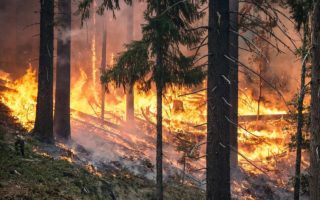
The COVID-19 pandemic has largely upended life as we know it, but other, more mundane threats to your respiratory health are still out there. If you live in certain areas of the United States, one of these threats is smoke from seasonal wildfires. Unfortunately, there is some reason to believe that exposure to this smoke could put people at higher risk for developing severe COVID-19 symptoms. Here’s what you need to know about the connection between COVID-19 and wildfire smoke.
How Could Smoke Put You at Higher Risk?
Smoke is one of several environmental pollutants that has been implicated in COVID-19 risk. Exposure to certain pollutants can both increase a person’s risk of infection and make him or her more likely to develop severe symptoms. Some analyses have suggested that the combination of low air quality and outbreaks of COVID-19 can increase case counts and deaths by as much as 10 percent.
Primarily, this effect is a result of fine particulate matter in wildfire smoke. These ultra-fine particles are believed to suppress immune response and worsen inflammation, potentially leading to more cases of COVID-19 and more severe symptoms in those cases. It should be noted that research into how fine particulates suppress immune response is preliminary, but the effect is reasonably well proven.
Who Is Most at Risk?
Needless to say, those with the most exposure to smoke are also those who will have the highest chance of experiencing the negative impacts of COVID-19 and wildfire smoke. Firefighters, people living nearest to active fires and people who work mostly outdoors in places affected by smoke all fall into this category.
Just because you aren’t in a high-risk category, though, doesn’t mean you’re completely safe. Low-level exposure to dispersed wildfire smoke may still raise your risk of contracting COVID-19 or developing severe symptoms. If you’re in an area where wildfire smoke is affecting air quality, there’s a good chance you’re at least slightly more likely to experience COVID-19 problems.
How Can You Protect Yourself from the Combination of COVID-19 and Wildfire Smoke?
Obviously, there are limits to what you can do to protect yourself from ambient smoke outdoors. Inside your home or office, however, you can take steps to improve air quality. One of the most effective methods is to use a combination HEPA and VOC air purifier that can handle the components of wildfire smoke. Some of our top recommended units for this purpose include:
In addition to using an air purifier, you can limit your time outdoors to keep yourself away from smoke. This includes closing windows and using a fan to circulate your home air internally, rather than drawing in air from the outside.
Although COVID-19 and wildfire smoke may not seem obviously connected, one is likely to increase the risk of the other. By taking the proper steps, you can keep yourself safe from wildfire smoke and reduce its possible effects on your risks of COVID-19.